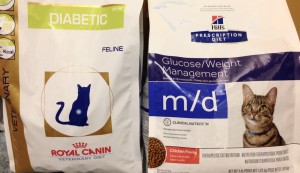What is Diabetes?
Did you know there are actually two forms of diabetes?
- Diabetes insipidus is a rare failure to concentrate urine due to a problem with antidiuretic hormone.
- Diabetes mellitus is the common ‘sugar diabetes’ where blood sugar levels are high due to a problem with insulin. From now on we’ll use the word ‘diabetes’ to refer to just this one.
What Causes Diabetes
Diabetes is caused by either a lack of the hormone insulin or a poor response to it. Insulin is responsible for moving glucose from the bloodstream into cells to be used as energy. Without sufficient insulin or response to it, glucose remains in the blood, leading to high blood sugar levels, called hyperglycemia.
When blood sugar levels get higher than the kidneys can filter out, glucose spills into the urine. This pulls more water with it through a process called osmotic diuresis. The excess water in the urine produces the characteristic signs of excessive urination, followed by an excessive thirst to keep up with the water loss. Persistent hyperglycemia, if left untreated, has severe effects on the body.
Symptoms Of Diabetes In Dogs & Cats
The most common symptoms you may notice if your animal has high blood sugar are all caused by the loss of glucose in the urine. They are:
- Urinating more
- Drinking more
- Weight loss
- Increased hunger
Other symptoms may include:
- Lethargy
- Sweet smelling breath (ketones)
- Urinary tract infections
- Cataracts and blindness
- Skin thinning and hair loss
- Hind limb weakness in cats
- Coma or collapse if ketoacidosis develops
If you notice any of these signs in your pet, please get them checked by your vet.
Which Animals Get Diabetes?

Diabetes can occur in all animals but is more common with:
- Obesity and inactivity, especially in cats (visit this link if you need help reducing your pet’s weight)
- Certain medications (eg cortisone)
- Age: middle-aged to older animals
- Other diseases (eg Cushing’s syndrome in dogs, chronic pancreatitis in dogs and cats)
- Certain breeds:
- Australian Silky Terrier
- Australian Terrier
- Cairn Terrier
- Miniature Schnauzer
- Poodle (Miniature and Toy)
- Samoyed
- Tibetan Terrier
- Cairn Terrier
- Burmese cats
Despite the common suspicion, diet doesn’t appear to cause diabetes (references below).
Diagnosis of Diabetes
After a thorough history collection and clinical examination, if there is any suspicion of the disease we will recommend performing a blood test. Urine testing is also useful, but the diagnosis of diabetes is easily made from the blood.
Once we have our diagnosis, we can then commence treatment.
Treatment of Diabetes
Please don’t ever think that you can’t do it. Every owner easily learns to give injections, no matter how scary it seems at the beginning. Watch this video, then watch how quickly an experienced owner does the same thing in the second.
This disease is one requiring lifelong treatment and management. Properly managed diabetes gives a dog or cat a normal quality of life and a normal lifespan.
The treatment of diabetes is based around giving your pet the right dose of insulin to keep the blood sugar levels under control. We have to walk the tightrope between too much insulin causing hypoglycaemia and not enough insulin causing hyperglycaemia.
Finding The Right Dose
Finding this correct insulin dose is where the challenge lies. Each animal responds to insulin differently. To work out what the correct dose is, we need a series of blood glucose graphs, where your pet spends a day in hospital. By taking a number of readings over the day we can see how long the insulin is working and how much is needed.
In some animals, this dose is relatively quick and easy to find; in others, the journey can be less predictable and take longer. Depending on your pet’s state of health, a hospital stay may be needed while insulin therapy is started and blood glucose levels are closely monitored.
Regulating the ideal blood glucose range can be tricky business, but we’re here to help you through it from start to finish.
Complications
The reason that insulin therapy is started with such great caution is that while persistent high glucose levels are bad, even momentary lack of glucose can be catastrophic. This condition, called hypoglycaemia, often starts with shaking or collapse and can lead to seizures and even death. If you ever suspect your pet has hypoglycaemia, smear a sugary syrup directly in the mouth and see a vet urgently.
Other complications that can make treatment difficult include:
- Insulin resistance or poor response to certain insulins
- Secondary urinary tract infections
- Other hormonal diseases like Cushing’s syndrome (dogs) or acromegaly (cats)
All of these can be treated.
Importantly, cataracts caused by diabetes need to be treated very early before they swell up and rupture their capsules. This can lead to severe uveitis and an inability to implant the new lens.
Feeding Diabetics
Management in dogs requires feeding two equal meals at 12 hourly intervals. Insulin is ideally given 90 minutes before the meal, but if control is good it is OK to give at the same time.
An ideal food for diabetic dogs is high in fibre (low glycemic index) to slow down release of glucose.

Management in cats is a little easier, as variations in diet do not affect blood glucose levels in the same way that they do in dogs. We do not recommend changes in a cat’s diet unless we are having problems.
An ideal food for diabetic cats is discussed in our page on high protein & low carbohydrate cat foods. Alternatively you can purchase the pictured diets.
Monitoring
The other crucial, and often overlooked, component of diabetic management is monitoring. At home monitoring of diabetic animals includes recording:
- Weight
- Changes in appetite
- Measuring water intake & urine output
- Checking for glucose in the urine with a dipstick
- Even possibly blood glucose levels, depending on the situation
Every diabetic animal is unique and an individual plan will be tailored to your pet’s needs- just book an appointment to discuss with us today.
Long-term Management
For dogs there is no ‘cure’ for diabetes, even though their life expectancy is excellent. However for cats, with good control, approximately one in four can go into remission. The picture hows one of our patients, Gati, who lived many years after coming off insulin without relapse.
Lastly, it’s important to remember that even once a diabetic is considered “stable”, continued management and monitoring is critical to maintain this status, as diabetes is a dynamic disease, and things can change even with the best, most consistent care. That’s why it’s important to check in with your vet regularly, even if your pet seems well, so that we can intervene early if needed.
Further Reading on Diet and Diabetes in Cats
McCann, T. M., Simpson, K. E., Shaw, D. J., Butt, J. A., & Gunn-Moore, D. A. (2007). Feline diabetes mellitus in the UK: the prevalence within an insured cat population and a questionnaire-based putative risk factor analysis. Journal of Feline Medicine & Surgery, 9(4), 289-299.
Slingerland, L. I., Fazilova, V. V., Plantinga, E. A., Kooistra, H. S., & Beynen, A. C. (2009). Indoor confinement and physical inactivity rather than the proportion of dry food are risk factors in the development of feline type 2 diabetes mellitus. The Veterinary Journal, 179(2), 247-253.

